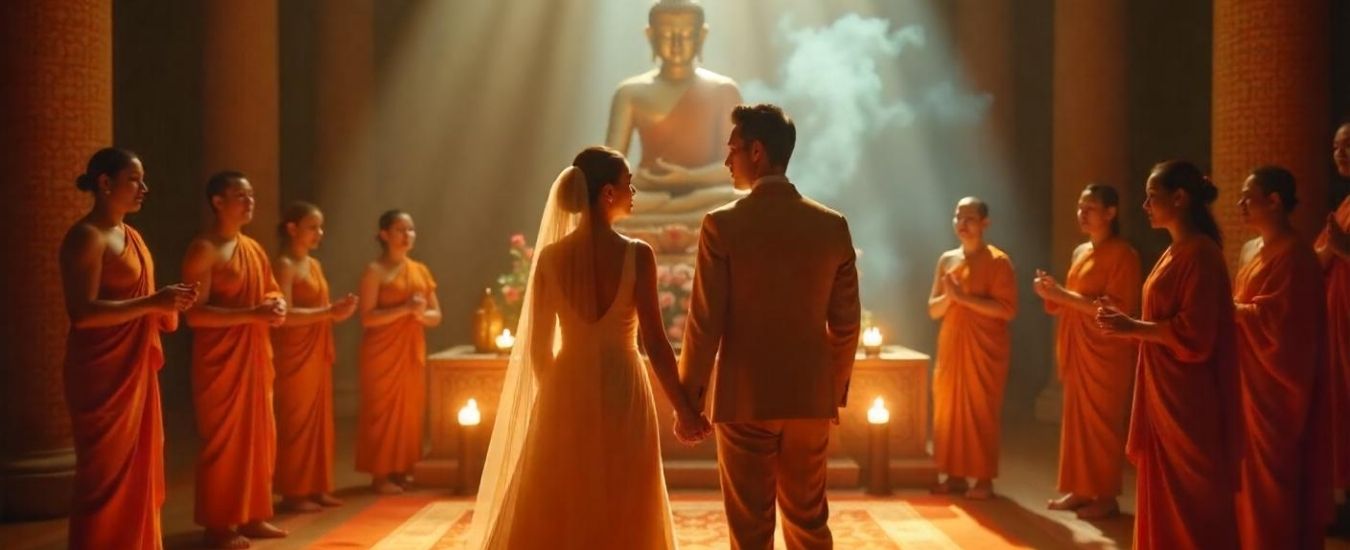When you think of a Buddhist wedding, you might envision a tranquil ceremony in a temple, with soft chanting, meditative silence, and monks or nuns offering blessings. While these elements do appear in many Buddhist marriages, the tradition is far more nuanced.
Buddhist marriages in India reflect a perfect blend of ancient wisdom and modern relevance. Whether you’re inspired by Theravada simplicity, Mahayana symbolism, or Ambedkarite ideals, a Buddhist wedding offers a path rooted in love, mindfulness, and equality.
Unlike other Indian marriage customs that emphasize lavish displays and complex rituals, Buddhist weddings emphasize simplicity, mindfulness, and ethical values rooted in the teachings of Gautama Buddha. But are they traditional or modern? The answer is both.
What Makes Buddhist Marriages Unique?
The uniqueness lies in the Buddhist view of marriage—not as a religious sacrament but as a social contract grounded in compassion, mutual respect, and non-attachment. There’s no prescribed Buddhist wedding ceremony in the scriptures. Instead, couples are encouraged to align their union with spiritual values and the Eightfold Path.
Is Marriage a Religious Sacrament in Buddhism?
No. In Buddhism, marriage is not a spiritual obligation. According to Buddha’s teachings, it’s a worldly engagement. It allows two individuals to build a life together based on the Right Action, Right Speech, and Right Intention—core elements of the Eightfold Path.
Historical Perspective of Buddhist Marriages
Origins in Ancient India
The roots of Buddhist marriages in India go back over 2,500 years. During Gautama Buddha’s time, marriage was seen as a means of building a harmonious domestic life, not a spiritual necessity. Buddha emphasized values such as honesty, kindness, and emotional detachment in relationships.
Buddha’s View on Married Life
While Buddha himself did not marry after renunciation, he provided guidance for lay followers through Dhammapada verses and other discourses. He emphasized:
- Mutual fidelity
- Non-violence
- Shared spiritual growth
Evolution Through Buddhist Schools
Theravada vs Mahayana Perspectives
- Theravada Buddhism (prevalent in Sri Lanka and Thailand) leans toward personal discipline and simplicity. Weddings often include chanting by monks and meditative practices.
- Mahayana Buddhism (practised in China, Tibet, and parts of India) is more symbolic. Ceremonies may involve offerings, mantras, and even Bodhisattva vows.
Cultural Fusion: Ambedkarite Buddhist Weddings
Influence of Dr. B.R. Ambedkar
In India, many Buddhists are followers of Ambedkarite Buddhism or Navayana. These communities often:
- Use readings from Ambedkar’s works instead of Vedic mantras
- Reject caste-based rituals
- Promote equality, rationalism, and dignity
Key Elements of a Buddhist Wedding
- Mindfulness rituals and meditation
- Exchange of garlands or symbolic items
- Reading or chanting of suttas (like the Metta Sutta)
- Emphasis on non-materialistic vows
- Spiritual blessing by monks via Dharma talks
Ceremony Details: Then and Now
Traditional Elements
- Lighting lamps and offering flowers at a Buddha statue
- Reciting the Three Jewels: Buddha, Dharma, Sangha
- Blessings using sacred threads or holy water
Modern Adaptations
- Registered marriage under the Special Marriage Act
- Use of personal vows aligned with Buddhist principles
- Simple attire such as saris, kurtas, or robes
- Small-scale ceremonies in temples, community halls, or homes
Role of Monks and Nuns
Monks or nuns (Bhikkhus and Bhikkhunis) do not officiate marriages but may:
- Offer spiritual blessings
- Lead chanting sessions
- Conduct pre-marital counselling
- Give short Dharma talks on the meaning of marriage
Interfaith and Intercaste Buddhist Marriages
Buddhism supports inclusivity. Whether it’s an intercaste or interfaith marriage, there’s no requirement for conversion or renunciation of prior beliefs. This makes Buddhist weddings a model of religious pluralism in India.
Legal Status of Buddhist Marriages in India
The Special Marriage Act
Since Buddhism doesn’t mandate religious rites for marriage, couples usually register under the Special Marriage Act, ensuring:
- Legal protection
- Equal rights
- Secular validity
Symbols and Vows in a Buddhist Marriage
The Eightfold Path as a Guide
Many Buddhist couples take vows aligned with the following:
- Right Intention
- Right Livelihood
- Right Effort
- Right Mindfulness
- Right Concentration
Common Wedding Vows
- “I vow to grow in compassion and mindfulness with you.”
- “I vow to help you reduce suffering and increase joy.”
- “I vow to practice non-attachment, even in love.”
Mantras, Chanting & Meditation
Role of Mantras
Ceremonies often include sacred mantras like:
- “Itipiso Bhagava…” (praising the Buddha)
- “Om Mani Padme Hum” (from Mahayana tradition)
Purpose of Chanting
- Invokes spiritual harmony
- Purifies the space
- Calms the couple’s mind
Regional Practices in India
Tibetan Buddhist Marriages
Include rituals like:
- Karma cleansing
- Offering butter lamps
- Use of silk khatas (scarves) to symbolize unity
Dalit-Buddhist Weddings
- Conducted without Brahmin priests
- Often accompanied by social reform speeches
- Sometimes held on Ambedkar Jayanti
Are Buddhist Weddings Religious or Secular?
They are both—or either. Buddhist weddings can be entirely secular (just legal registration) or deeply spiritual (infused with Buddhist values, chanting, and blessings). The choice is up to the couple.
FAQs
Do monks perform marriage ceremonies?
Not exactly. Monks don’t officiate but often offer blessings, lead chanting, and give Dharma talks.
Can a non-Buddhist marry a Buddhist?
Yes. Interfaith marriages are fully accepted in Buddhism.
Is dowry practised in Buddhist weddings?
No. Especially among Navayana Buddhists, dowry is strongly opposed.
What should one wear to a Buddhist wedding?
Wear modest, respectful attire. Avoid heavy jewellery or excessively bright colours.
How long does a Buddhist wedding last?
Typically between 30 minutes to 1 hour, including meditation, vows, and chanting.
